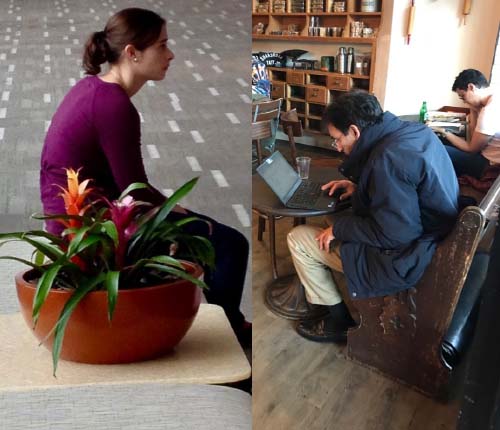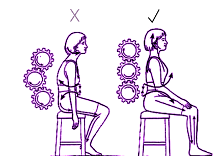What is “Correct & Proper Posture”?
If one of your parents told you to “stand up straight and stop slouching”, they were sort of right but not 100% accurate in just telling you to stand up straight since there is more to it than that. We have become a generation of slumpers. Slumped over a computer, slumped over a phone, slumped over while sitting…. it’s all I see wherever I go! As a certified ergonomist and health/wellness consultant, I know I am hypersensitive to noticing these things.
What concerns me is that even with the increased attention people pay to their body and health today, there often seems to be a disconnect when it comes to how we hold ourselves. This is evident in the lack of incorporating good body mechanics and posture for everything we do, especially at the workstation, where most people spend a majority of their time. Even when people are exercising (and you would think they are paying attention to their bodies), I often see that they are mindlessly going about their workout without truly being connected to their bodies and how they are using them.
“The Effect of Slump Sitting”
Think about this. Our muscles form around the posture that we keep. Just as they change shape and form when we exercise, your muscles change their shape and form around how you use your body during daily activities. The best example of this is slump sitting. When a person sits in a slumped position like the pictures below, this is what is going on with the body:
- The forward head position: A person’s head weighs on average 10-12 pounds. This person head position is putting excessive pressure on the cervical discs inviting them to bulge.
- The rounded shoulders: When the shoulders are in a rounded position, they are making the anterior deltoid muscles tight (the front part of the shoulder), and the chest muscles are also getting tight.
- The middle back muscles: They are getting overly stretched in this position and they should always be slightly contracted to help keep us upright and in good posture.
- The lower back: There is excessive pressure and compression on the lumbar discs when sitting back on the tailbone in this posture.
- The Core: One of the worst things about this negative posture for our body is that the core muscles cannot be engaged. In my opinion, this one of the things that most people don’t do enough of. Being connected to and using the core muscles throughout the day.

Notice now, all the negative things these types of posture can do to your body? The forward head position, rounded/hunched shoulders, over stretched middle back (with those muscles not engaged), leaning back on the tailbone, the core muscles are definitely not engaged in this position to help support the spine….etc.
It makes me cringe when I see this common posture!!!
It is so important to “connect to your core” during daily life. We have a built-in imbalance in our torso which is why so many people have back problems. Our spine is in-between our back muscles (that are always contracted to keep us upright), and the abdominals. Our side abdominal muscles, the intercostals, are contracted when we are upright. However, the main part of the abdominal wall, the rectus group, those are not contracted unless we actively engage those muscles. How often do you walk around with your belly muscles pulled in toward your spine like a belt that is on too tight? We tend not to unless someone walks by and we “suck in our belly” to look better My hopes are that in reading this article, it will help you become more aware and mindful of how you hold yourself throughout the day.
“How to Properly Sit at Your Desk”
What I am suggesting is that we try to “Connect to the Core” by utilizing all the core abdominal muscles on a more consistent basis. This is an active way to function at your workstation. To give you a visual of this try these 5 steps next time you are sitting, or standing at your workstation:
- Put your hands on those side abdominal muscles under your ribs and to the side and pull them toward the middle of your belly (think of a seat belt clicking in).
- Pull your front abdominals in toward the spine to engage those muscles (think of a belt or pants you are wearing that are too tight).
- Maintain 3 – 4 fingers of space between the bottom of your rib and the top of your hip. If you have that, it means you are properly pulled in with your core muscles.
- Keep your back in its natural curve and do not go into a pelvic tilt. That position engages the buttock muscles, and you are trying to just focus on using all your major core muscles to do this.
- Breathe more from the rib cage area while you are working on this.
When you sit or stand like this, notice what happens to the rest of your body. It naturally does what I call the “zip up”. Your chest naturally opens up, your shoulders relax and drop down, you engage your middle back muscles, your head aligns properly with your earlobes over your shoulders…. it’s beautiful! If you stand at a workstation, make sure you keep your knees slightly bent, and stand evenly on both feet.
Behavior change,(internal text link) for whatever you are trying to work on for your body and your health takes time and patience! Focus on the small steps that you can take toward that change rather than what your eventual goals is. Good desk posture is easy to achieve by by incorporating small incremental changes. For example, if your goal is to use your core muscles as much as possible throughout the day, steps toward that goal could be:
- Start with one minute out of every hour where you intentionally connect to your core as described above.
- Use something to remind yourself to do this such as a timer, an alarm, go old school and put a stickie on your computer….etc.
- After holding yourself in that beautiful posture, forget about it and go about your business.
- Over time, gradually increase the amount of time you intentionally spend in that posture to three minutes, then increase to seven minutes and so on.
- When you get to the point that you can hold that posture for a solid fifteen minutes without it being an effort, that will become your new normal!
- You will find that when you do forget (which is normal), and go into a slumped posture, you will self-correct.
By approaching behavior change this way, in small incremental steps, you set yourself up to succeed since it is easier to achieve one small step verses reaching the final goal. When we focus on final goal instead, we set ourselves up to fail since it is hard to go from nothing to suddenly, a complete behavior change.

“What Does Good Posture Feel and Look Like”?
If you are sitting, it feels like you are lifted up and out of the seat and very light on your sit bones. If you are standing, it feels like you are taller, stronger and supported. It feels like you almost have a back brace on except you don’t. It is all from being mindful of your body and from being“ connected to your core”.
Training yourself to work this way and to have better posture throughout your daily life will not only help you feel better and have less back pain, but it will also improve the tone in your muscles. Even if you don’t exercise, most of the muscles in our body have tone from daily use. Your thigh muscles have tone from walking, standing up and sitting down. Your arm muscles have tone from lifting things; groceries, children, boxes…etc. The main front part of our abdominals, need to be actively contracted in order for those to be engaged and build tone. The saying “use it or lose” rings very true when it comes to your core muscles!
What does proper posture look like?
Here is a link to a short video to see what it looks like to be “Connected to Your Core”! and have proper posture while sitting (this is the link text)
Avoid sitting for too long
Having good body mechanics and posture while you work is so important but so is taking frequent breaks! It is easy to sit at your desk for hours on end and pain is your reminder to move and stretch. Just as you hopefully train yourself to sit well and connected to your core, incorporating a better workflow is crucial. The following are break suggestions to (gradually and over time), make your “new normal” for how you work:
“Take a Break”!
Whether you are in the office or working from home these practical tips will help prevent injuries and encourage healthy habits.
- For every 20 minutes of keying, take your hands off the keyboard and do an alternative task for 1 – 2 minutes
- For every 50 minutes of a static posture (sitting or standing since both are static postures), get up and walk around for at least 5 minutes
- Stand up to answer the phone, walk while talking on the phone using a wireless headset (best invention for freedom of movement!)
- Stretch at your workstation during the day
- There are many online resources for how to properly stretch, and you can do stretches right in your chair at your desk.
- Drink plenty of water and refill your water bottle as far away from your workstation as possible so it will make you move more.
- Look at something far away and stare at it for a minute or two. Blink and refocus. This can help with eye strain.
Here is an example of a class that I teach called “Stretch Breaks at Your Desk”

